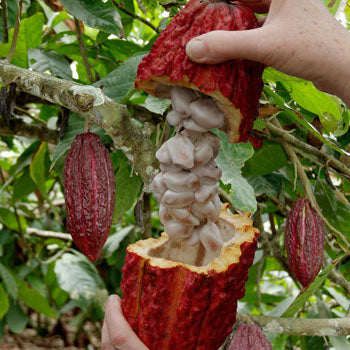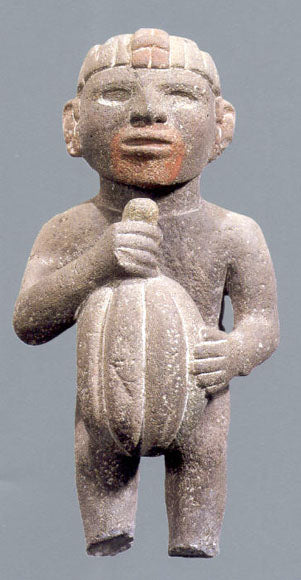All About Cacao - The Origins of Chocolate
We’re all familiar with chocolate, in one form or another. Whether that’s a bitter, rich high cocoa content dark chocolate, a sickly-sweet milk or white chocolate, or a milky drink we sup at night before bedtime or when it’s cold outside. What many people don’t know is quite where our chocolate comes from.
All chocolate starts its life as a seed, in a pod, on a tree. The tree in question is the Theobroma cacao tree, which literally means; cacao, the food of the gods!
 The evergreen cacao tree is thought to be native to Central and South America, not particularly big, up to 30 feet tall, and thrives growing in the shade of larger trees. The tree flowers all year round, producing pod-like fruit that start green in colour and develop into a range of yellow, red, orange, purple or blue shades. Each fruit contains from 20-50 seeds, about the size of large almonds. It is from these seeds, also called beans, which all chocolate comes from.
The evergreen cacao tree is thought to be native to Central and South America, not particularly big, up to 30 feet tall, and thrives growing in the shade of larger trees. The tree flowers all year round, producing pod-like fruit that start green in colour and develop into a range of yellow, red, orange, purple or blue shades. Each fruit contains from 20-50 seeds, about the size of large almonds. It is from these seeds, also called beans, which all chocolate comes from.
Types of Cacao
There are three main varieties of the cocoa plant: Criollo, Forastero and Trinitario.
Criollo
In Spanish, this means 'native' or 'of local origin' originates from Central America, probably from Mexico. This was the first cacao variety to be cultivated in pre-Columbian times. The Criollo pods are elongated and ridged, usually red or yellow but may also be blue. Known for it's complex, powerful flavours that can be fruity or spicy, it's intense aroma and lacking in bitterness. The species is susceptible to disease with a lower yield and late ripening. It now accounts for around 5% of the world crop, grown mainly in Venezuela, Ecuador, Colombia and Indonesia.
Forastero
Spanish for 'foreigner' or 'stranger' originally from the Amazon basin and domesticated later than Criollo. Forastero cacao is generally a strong, vigorous plant that grows quickly, the pods are rounder than Criollo and coloured yellowish through to deep orange, with shallower ridges. It produces a lot of fruit, accounting for over 80% of the world's cacao and is grown mainly in Africa and Asia. The beans can have a fat content of up to 50%, Forastero cacao has a more bitter flavour and is the workhorse cacao.
Trinitario
This is the hybrid of Criollo and Forastero cacao and dates back to the 1700's and as the name suggests, developed in Trinidad. It was a naturally occurring hybrid, the result of cross-pollination between Forastero trees and the few Criollo trees that survived a natural disaster in the early 18th century. Trinitario cacao has the delicate flavour and intense aroma of the Criollo, combined with the more robust constitution of the Forastero bean. Grown mainly in Indonesia, Sri Lanka, the West Indies and South America, it represents about 10-15% of the world's total production.
Until the 18th century, plantations mostly grew Criollo beans. However, today they make up around 5% of cocoa production, with high-yielding Forastero dominating the world market for bulk, mainstream processing.
Arriba Nacional
Just to add to the potential for confusion, there is Arriba Nacional, a variety of cacao specific to Ecuador and regarded as distinct from Criollo. During the early 1600s, small plantations of Nacional cacao existed along the Guayas River shores located in a region called "Arriba" that spread its tributaries to the Duale and Babahoyo upward rivers. The strong floral aroma these trees developed, which is unique to the Nacional cacao is called the ‘Arriba’ flavour. Over the years with the introduction of other cultivars, further hybridisation occurred, but many of the true Arriba Nacional cacao trees remained. Today Nacional cacao is exclusive to Ecuador and considered to be among the world’s finest. The Arriba Nacional cacao trees are grown in mineral-rich volcanic soil at high elevation in Ecuador. The cacao trees are carefully cultivated to organic standards in this unpolluted natural environment.
 Ancient chocolate
Ancient chocolate
Humans have a long relationship with chocolate, dating back some 3000 years or more to the time of the Olmec civilization that lived in what is now south-central Mexico. In fact, it is believed that the word cacao derives from the Olmec people, who called it kakaw.
Following on from the Olmec, came the Mayans, who took cacao to the heart of their culture. They used cacao ceremonially and shamanistically, even having a baptism ritual for boys and girls that involved cacao. The Mayans were the first major civilization to use cacao beans as currency and had numerous gods associated with cacao.
When the Spanish conquistador Hernan Cortes landed in 1519 he found an Aztec civilization with cacao at the centre of their culture. The last Aztec Emperor, Montezuma was a renowned chocoholic, recorded by Spanish chroniclers to consume up to 50 cups of a cacao drink from gold vessels at feasts, before visiting his harem.
It is most likely that Cortes brought cacao to Europe and from there the world. The rest, as they say, is history.
Cacao, cocoa, modern-day chocolate
The cacao consumed in its native lands of the Americas was a bitter, spicy affair, often consumed as a drink. It was the Europeans that combined cacao with refined sugar, first as a drink and later as solid chocolate bars. Today, cacao is more widely known as cocoa, which started out as a British slang term for cacao.
In 1828, a Dutchman invented a process for removing a lot of the fat, the cacao butter, from the cacao. The residue could be ground into a powder and was then treated with alkaline salts to improve how it mixed with water. The process is known as “Dutching” and the end product is known as cocoa or cocoa powder. The first bars of milk chocolate was produced in 1879, by combining defatted and alkalized cocoa powder with milk powder recently invented by Henri Nestlé. These processes then led to mass production of cheap, low-quality chocolate.
Recent years have seen a renaissance in good quality chocolate, with increasing numbers of people no longer satisfied with cheap chocolate, packed full of refined sugars, additives and vegetable oils. There are now artisan producers of chocolate around the world, focusing on good quality cacao beans and ingredients, carefully made in smaller batches.


 Ancient chocolate
Ancient chocolate